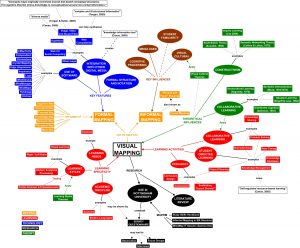Types of Visual Tools and Mapping Visual mapping is a means of graphically representing ideas, conceptual relationships and progression paths. They range from the simple spider diagram, flow chart or time line – to more sophisticated models such as Buzan’s Mindmap, Edward de Bono’s Flowscape, Joseph D. Novak & Alberto J. Cañas Concept Maps, and David Hyerle’s Thinking Maps® which can be used to explore complex relationships, perspectives and perceptions. Visual representation are thought to aid understanding and memory because it better fits with the brains method of processing information than standard note-taking, as the brain stores information in patterns and associations, not linearly.
Visual mapping is a means of graphically representing ideas, conceptual relationships and progression paths. They range from the simple spider diagram, flow chart or time line – to more sophisticated models such as Buzan’s Mindmap, Edward de Bono’s Flowscape, Joseph D. Novak & Alberto J. Cañas Concept Maps, and David Hyerle’s Thinking Maps® which can be used to explore complex relationships, perspectives and perceptions. Visual representation are thought to aid understanding and memory because it better fits with the brains method of processing information than standard note-taking, as the brain stores information in patterns and associations, not linearly.
Visual tools also have the capacity to be used to stimulate meta-thinking skills. Tony Buzan, who pioneered the use of mind maps back in the 1970s, argues that mind maps encourage creativity. The process of graphically organising information on the same page stimulates the mind to make associations, and it is through making such associations that the creation of new ideas occur.
Brainstorming
Brainstorming is a diagram used to visually organize ideas on one concept. An example is mindmapping, which is hierarchical and shows relationships among pieces of the whole. It is often created around a single concept, drawn as an image in the center of a blank page, to which associated representations of ideas such as images, words and parts of words are added. Major ideas are connected directly to the central concept, and ideas branch out from those.
Concept Maps and Diagrams
A concept map is a conceptual diagram that depicts suggested relationships between concepts. It is a graphical tool that instructional designers, engineers, technical writers, and others use to organize and structure knowledge. A concept map typically represents ideas and information as boxes or circles or similar shapes, which it connects with labeled arrows in a downward-branching hierarchical structure. The relationship between concepts can be articulated in linking phrases such as causes, requires, contributes to, categories, comparing,or relationships.
Graphic Organizers
A graphic organizer is a pedagogical tool that uses visual symbols to express knowledge, concepts, thoughts, or ideas, and the relationships between them. The main purpose of a graphic organizer is to provide a visual aid to facilitate learning and instruction. Graphic organizers are usually selected by the facilitator to use for a specific concept understanding.
Visual Language
A visual language connects the ideal of mindmapping, graphic organizers and concept mapping to have a language that represents cognitive processes. Each visual map represents a cognitive process (e.g. comparing, categorizing) to organize our ideas.
Frame of Reference
Frame of Reference is a person’s experiences that frames their beliefs and decisions.
Thinking Maps® (Visual Tools)
Thinking Maps® are consistent visual patterns linked directly to eight specific thought processes. By visualizing our thinking, we create concrete images of abstract thoughts to reach higher levels of critical and creative thinking individually and collaboratively. Thinking Maps® establish a consistent language for thinking and problem solving. The goal is to have the students work independently choosing the cognitive process of a Thinking Maps® that best supports their thinking.
The language of Thinking Maps® is a language of eight fundamental cognitive skills. These eight cognitive skills, as shown on the next page, are based on a synthesis of cognitive science research, models of thinking developed for psychological testing and educational programs, and a transformation of Dr. Upton’s early work with Designs for Thinking. This model is neither linear nor hierarchical. The eight cognitive skills are defining in context, describing attributes, comparing and contrasting, classification, part-whole spatial reasoning, sequencing, cause and effect reasoning, and reasoning by analogy. Each of the eight processes additionally can have a Frame of Reference to further expand information, schema and thinking. This language is not a comprehensive view of thinking; it identifies the coherence and interdependency of the eight fundamental cognitive skills that ground thinking and learning.

